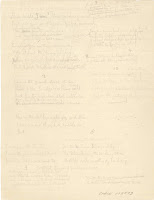 For those of you who have ever struggled with the rise on your sourdough or battled with making the perfect baguette, a study of Sylvester Graham's Treatise on Bread and Bread-making (Boston: Light & Stearns, 1837) may be in order. Published in 1837, Graham's treatise was the first book of its kind solely focused on the subject of bread and bread making. Graham, though best known for being the inventor of the Graham cracker, advocates strongly for the consumption of bread in the daily diet. "There are probably few people in civilized life," he writes, "who…would not say that they consider bread one of the most, if not the most important article of diet which enters into the food of man."
For those of you who have ever struggled with the rise on your sourdough or battled with making the perfect baguette, a study of Sylvester Graham's Treatise on Bread and Bread-making (Boston: Light & Stearns, 1837) may be in order. Published in 1837, Graham's treatise was the first book of its kind solely focused on the subject of bread and bread making. Graham, though best known for being the inventor of the Graham cracker, advocates strongly for the consumption of bread in the daily diet. "There are probably few people in civilized life," he writes, "who…would not say that they consider bread one of the most, if not the most important article of diet which enters into the food of man." Split into eight parts, the treatise covers topics such as bread's long history, its properties, varieties, fermentation, and of course, the fine art of preparation. Because Graham believed strongly that the best bread makers were wives and mothers, his treatise was so controversial that heated bakers threatened to riot whenever he spoke. During a time in Britain where most recipes were passed down through word of mouth, Graham's Treatise on Bread and Bread-making takes the reader through a journey of the entire bread making process; from harvesting the wheat, to developing a strong yeast, and the first real technical instructions as to how to craft the best tasting breads. Want a sweeter, richer bread? Use fresh ground meal. A wholesome daily bread? Forgo the barley and prepare coarsely ground rye mixed with Indian meal. Though in age of pre-packaged baked goods and fast acting yeasts some of Graham's ideas may indeed seem obsolete, much can be learned from his precise history and attention to detail.
Come and take a look at the 1837 publication and view other tips Graham has for bread makers by asking for Rare Book TX 769 .G68.


